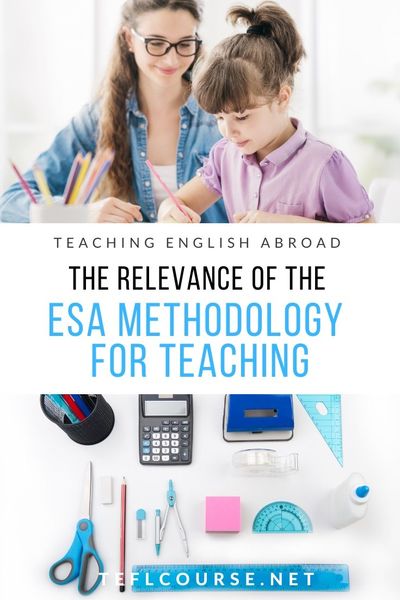The Relevance of the ESA Methodology for EFL Teaching

The acronym ESA stands for Engage, Study and Activate. The ESA methodology of teaching English as a foreign language is one of the most progressive and productive methods. It draws its strengths from the other teaching methods that were used before it. The ESA method incorporates the good aspects and advantages of the old teaching methods thereby making it a powerful method. Some of the earlier teaching methods from which the ESA teaching methodology drew its strength are the task-based learning, the communicative language teaching, the community language learning, the silent way, the suggestopedia, and the lexical approach. The ESA method has therefore managed to take the positive aspects from the other teaching methods and this has made it become one of the best teaching methods in the field of EFL.
Table of Contents
Reasons to Implement ESA Method
Do you want to teach English abroad? Take a TEFL course!
This post was written by our TEFL certification graduate Daniel M. Please note that this blog post might not necessarily represent the beliefs or opinions of ITTT.
Reasons to Implement ESA Method
The ESA method is relevant and important in teaching English as a foreign language because, throughout its three stages, it insists that the teacher should use English in the classroom and avoid using the students' L1 language. Similarly, the teacher should also not allow learners to use their native language. This is a very strong pillar for the ESA methodology because if learners and teachers are to be allowed to use their native languages, learners will find it difficult to practice and learn English. English has to be practiced all the time in every lesson.

Also Read: 4 Essential Tools For Teaching ESL Online
First Lesson Stages
The Engage phase of the ESA methodology acts as a warmer before the Study phase. The Engage phase allows the teacher to break the ice in the class since it is the first phase. In breaking the ice, learners and the teacher will be using English. The teacher could introduce a topic or a language point that is linked to what will be done in the study phase or something different from the language point that will be tackled in the Study phase. The main idea in this phase is to get learners thinking and talking in English. This will help reduce stress and anxiety among learners thereby facilitating a very conducive learning environment. Needless to say, a very creative teacher will allow for high student talk time and at the same time captivating the attention of the learners.
In the Study phase, that is where students learn new language concepts. The teacher should not just spoon-feed the learners but should rather elicit as much as possible from them. The teacher should do the board work - only writing what is important clearly and neatly. Examples have to be done on the board before handing out material. If the teacher writes unimportant information, students will copy everything and that will create confusion in learners towards understanding the language point being taught. The Study phase of the ESA methodology recommends a 3x3 drill, three times chorally, followed by three individuals.
Also Read: How do I get a job teaching English in South Korea?
Points to Remember
Before handing out material, the educator must do examples on the board eliciting answers from the students. This will help the learners follow and understand what they will be expected to do when they do activities as individuals, pairs or groups.
After the exercise has been given out to the learners, the teacher should not interrupt the learners. However, the teacher has to monitor the students to make sure that learners are doing their work.

The Point of ESA
The ESA methodology stresses that all the students must stop writing and listen attentively to the feedback. During the feedback time, the teacher should allow the students to correct the work. The teacher can only come in to correct the work after the students have tried and failed or when the teacher feels that some additions to the students' answers have to be added for clarity. This makes the ESA methodology to be learner-centered. If the learners do the corrections themselves, the chances of forgetting the language point in question are very slim. The other positive thing is that if students can make accurate corrections, that on its own will be a clear signal or confirmation to the educator that learners have understood the language point taught.
Also Read: The Top 5 Places to Teach English in Vietnam
Practical Stage
The Activate phase of the ESA teaching methodology is important because it encourages students to be creative with the language point taught and English Language in general. In other words, learners are allowed to use the English Language they already know and what they would have just acquired.
The Activate phase also demands that the educator demonstrate exactly what the learners are required to do before they can complete the activity. During the briefing stage, students have to be involved in the demonstration and the educator has to ask them to say exactly what they are going to do. This gives a clear indication to the educator as to whether or not the students have understood what they are required to do. If the educator feels that the students are not quite clear of what they are expected to do, then he/she will have to explain to them once more clarifying problematic areas.
Points to Remember
The educator must only hand out the material after making sure that every student knows exactly what has to be done.
Once the activity has started, the educator must not interrupt the learners. The educator may join the students if he/she feels the necessity to do so.

Also Read: 8 Must-Visit Places When Teaching English in Mexico
Feedback
After the students have presented their work, the educator has to give feedback. The feedback is vital for the teacher because it helps the teacher know whether the lesson has been understood or not. If not understood, then more clarification will be needed. This is another strength of using the ESA methodology in teaching EFL.
The ESA methodology comes with several variations such as the Straight Arrow, The Boomerang and the Patchwork ESA lessons. These variations to the ESA methodology gives teachers a variety in their teaching approach. For a creative teacher, using these different varieties of ESA methodology will remove predictability of how his/her lesson will flow among learners. Learners will not be bored. This will therefore likely remove boredom and increase curiosity, interest, and participation among learners.
Do you want to teach English abroad? Take a TEFL course!
It can, therefore, be concluded that if used correctly and effectively, the ESA teaching methodology can improve learning and produce good results in learners of EFL.
Apply now & get certified to teach english abroad!
Speak with an ITTT advisor today to put together your personal plan for teaching English abroad.
Send us an email or call us toll-free at 1-800-490-0531 to speak with an ITTT advisor today.
Related Articles:
- How do I get a job teaching English in South Korea
- 10 Questions You Need to Ask Before Enrolling In a TEFL Course
- The 10 Best Destinations for Teaching English Abroad in 2018
- Online or In-Class - Which TEFL Course Should You Take?
- The Best Government Programs For Teaching English Abroad
- What Scams to Look Out for When Looking for TEFL Jobs




